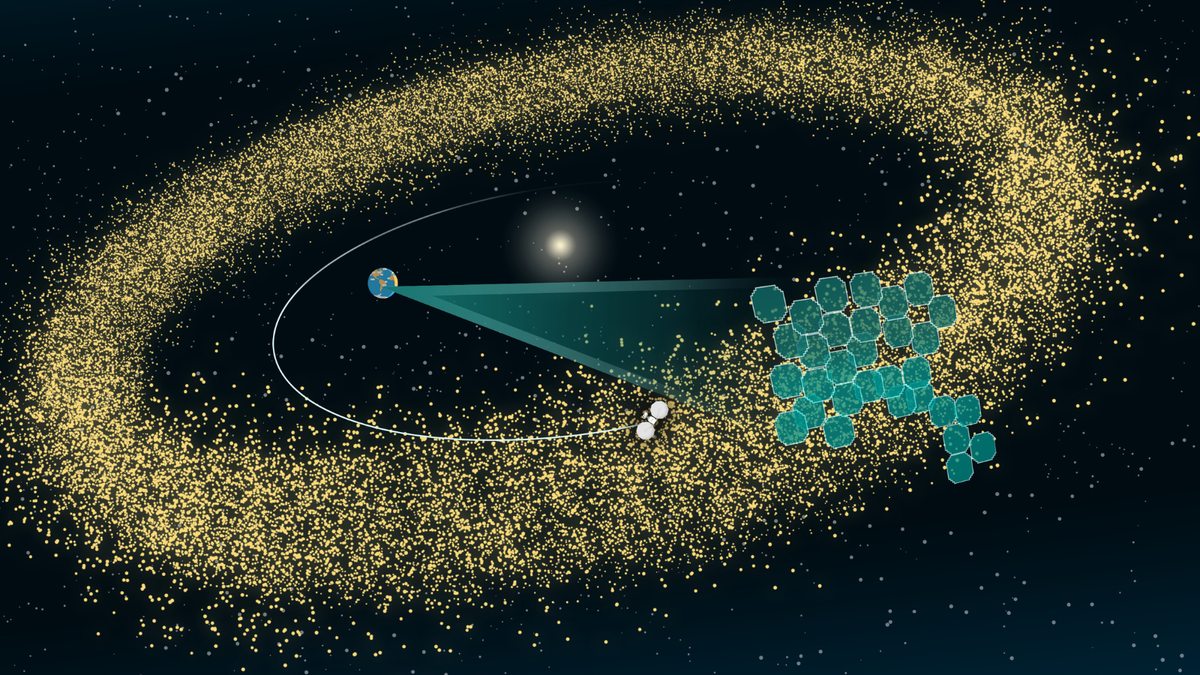How Earth's new Rubin Observatory will usher in the next era of asteroid space missions
By Robert Lea published about 8 hours ago
"Nothing will come close to the depth of Rubin’s survey and the level of characterization we will get for solar system objects."

An illustration of the asteroid belt as a dense donut-shaped ring of yellow points with the Sun at the center. The background is black with hints of dark blue in the corners and small white pinprick stars sprinkled throughout. A small illustrated Earth sits to the left of the Sun, and a semi-opaque, cone-like teal triangle extends from Earth toward the right. The cone opens up to a mosaic of a couple dozen small, square-like shapes representing Rubin Observatory’s LSST Camera’s detector area. The mosaic is overlaid onto a portion of the asteroid belt, and each tile represents a camera image that detects a group of asteroids. A thin curved white line begins behind the Sun and swings out around the Earth, tracing the path of a small, not-to-scale spacecraft heading toward the illuminated asteroids, ready for exploration.
An illustration shows hexagon shaped footprints project on a band of asteroids representing the view of the Rubin observatory (Image credit: RubinObs/NOIRLab/NSF/AURA/J. Pinto)
The forthcoming Vera C. Rubin Observatory will never leave Earth itself, but the highly detailed, "big picture" view of the cosmos it will offer scientists may very well kick-start a new era of space exploration.
The solar system is filled with billions of small rocky bodies and icy objects, many of which formed around 4.5 billion years ago when planets like the Earth were forming around the sun. Space missions like NASA's OSIRIS-REx, Lucy, and Psyche have been making strides in visiting these primordial solar system bodies. They've been collecting images, and OSIRIS-REx even snagged a few samples, for investigation here on Earth — all informed by data collected by observatories across the globe.
Rubin, which will see its "first light" in 2025, will be capable of detecting millions of new asteroids, comets and potentially even bodies passing through our planetary backyard from other systems. Take Oumuamua, for instance, which was first spotted in 2017. After detecting these bodies, Rubin will then quickly track them as they move around the solar system and tread close to Earth — or even if they remain in the main asteroid belt between Mars and Jupiter.
"Nothing will come close to the depth of Rubin's survey and the level of characterization we will get for solar system objects," Siegfried Eggl, Assistant Professor at the University of Illinois Urbana-Champaign and Lead of the Inner Solar System Working Group within the Rubin's Solar System Science Collaboration, said in a statement. "It is fascinating that we have the capability to visit interesting objects and look at them close-up. But to do that, we need to know they exist and where they are.
More:
https://www.space.com/rubin-observatory-next-era-space-missions-asteroids
